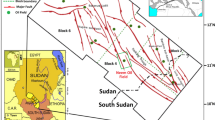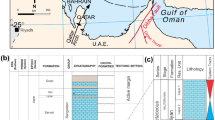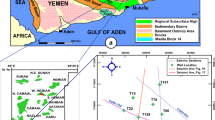Abstract
The paleokarst zones developed in the Ordovician Yingshan Formation carbonates represent significant hydrocarbon reservoirs in the Tahe area, western China. In this type of reservoir, the identification of pay zones is problematic. The challenge is due to high uncertainty regarding spatial dimensions, sorting, lithological heterogeneity, and the texture of paleokarst fillings. Therefore, we focus on the physical characterization of these reservoirs using an integrated multidisciplinary approach applied to each filling type. Our methodology includes scanning electron microscopy (SEM) and micro-macroscopic sedimentological analyses, as well as petrophysical evaluations using the borehole image logs (FMI) and dipole sonic imager (DSI). The study specifically focused on three filling types: (i) clastics, (ii) breccia, and (iii) chemical deposits (i.e., chert and calcite cement). We generally recognized these fillings in well core samples recovered from the study area. Our results revealed that the lithofacies with the best features for oil recovery are related to fine-grained sandstones. This lithofacies is characterized by an average effective porosity and permeability range from 5 to 12% and from 5 to 50 mD, respectively. The unfilled crackle breccia and empty cavities also show an average effective porosity and permeability range from 4 to 9% and from 10 to 20 mD, respectively. Although the chert deposits interbedded with carbonates exhibit substantial fracture density, their detection using well logs remains a challenge because of the deposits’ thin thicknesses (around 10–15 cm in vertical scale). Moreover, we highlight how the textural immaturity and high calcite precipitation in the matrix significantly impact the reduction of storage capacity in the chaotic breccia. As a validation method, we compare rock typing results obtained from well logs and core sample data. The outputs show an excellent general correlation between the determined rock types. Finally, we propose a classification scheme for the paleokarst fillings exclusive to the Tahe area.


















Similar content being viewed by others
References
Alberty MW (1994) Standard interpretation; part 4-wireline methods. In: Morton-Thompson D, Woods AM (eds) Development geology reference manual, AAPG Methods in Exploration Series 10, pp 180–185
Archie GE (1952) Classification of carbonate reservoir rocks and petrophysical considerations. AAPG Bull 36(2):218–298
Chen D, Wei X (2010) Well logging evaluation on fractured carbonate reservoirs in Tahe area. Pet Geophys Explor 49:147–152
Chen QL, Qian YX, Ma HQ (2003) Diagenesis and porosity evolution of the Ordovician carbonate rocks in Tahe oilfield, Tarim Basin. Pet Geol Exp 25(6):734–744
Chen Q, Zhao Y, Li G, Chu C, Wang B (2012) Features and controlling factors of epigenic karstification of the Ordovician carbonates in Akekule arch, Tarim Basin. J Earth Sci 23(4):506–515
Dell’oca S (1961) Riempimenti naturali di grotte: Como, Italy. Rassegna Speleologica Italiana, p 277
Ellis DV, Singer JM (2008) Well logging for earth scientists, 2nd edn. Springer, Berlin, p 728
Guo J (1996) On the paleokarst of lower Paleozoic group, Tarbei and Tarzhong regions of Tarim. Carsologica Sin 3
He Z, Peng S, Zhang T (2010) Controls on reservoir formation in Ordovician of Tahe oilfield, Tarim Basin, and combinational genetic mechanism. Oil Gas Geol 31(6):743–752
Heydari E (2003) Meteoric versus burial control on porosity evolution of the Smackover Formation. AAPG Bull 87(11):1779–1797
Jin Q, Kang X, Tian F (2015a) Genesis of chemical fillings in fracture caves in paleo-karst run-off zone in Ordovician and their distributions in Tahe Oilfield, Tarim Basin. Acta Pet Sin 36(7):8
Jin Q, Kang X, Rong Y, Tian F (2015b) Sedimentary and geochemical characteristics of sandstone and mudstones deposited in surface rivers and subsurface rivers in Ordovician Karsted carbonates. Tahe oilfield. J China Univ Pet (Ed Nat Sci) 39(6):1–10
Jin Q, Tian F, Lu X, Kang X (2015c) Characteristic of collapse breccia filling in caves of runoff zone in the Ordovician karst in Tahe oilfield, Tarim Basin. Oil Gas J 36(5):729–735
Kang X, Jin Q, Tian F, Li Y, Zhang H (2013) Based on the filling evaluation of carbonate paleokarst reservoir poroperm characteristics in Tahe Oilfield, Tarim Basin. Poster presented at AAPG Annual Convention and Exhibition, Pittsburgh, U.S.A. Article N° 90163
Kennedy M (2015) Practical petrophysics. Elsevier, Amsterdam, p 420
Kerans C (1988) Karst-controlled reservoir heterogeneity in Ellenburger Group carbonates of west Texas. AAPG Bull 72(10):1160–1183
Li Y (2017) Development theories and methods of fracture-vug carbonate reservoirs. Elsevier, Beijing, p 514
Li B, Jia C, Wang W, Yu C, Li F, Liu P (2014) Characteristic and main controlling factors of karst caves in the Tarim Basin. Poster presented at AAPG Annual Convention and Exhibition, Houston, U.S.A.
Li Y, Kang Z, Xue Z, Zheng S (2018) Theories and practices of carbonate reservoirs development in China. Pet Explor Dev 45(4):712–722
Liu C, Lin C, Wang Y, Wu M (2008) Burial dissolution of Ordovician granule limestone in the Tahe oilfield of the Tarim Basin, NW China, and its geological significance. Acta Geol Sin 82(3):520–529
Loucks RG (1999) Paleocave carbonate reservoirs: origins, burial-depth modifications, spatial complexity, and reservoir implications. AAPG Bull 83:1795–1834
Loucks RG (2001) Modern analog for paleocave-sediment fills and their importance in identifying paleocave reservoirs. Gulf Coast Assoc Geol Soc Trans 46:195–206
Loucks RG, Anderson JH (1985) Depositional facies, diagenetic terranes, and porosity development in lower Ordovician Ellenburger dolomite, Puckett field, West Texas, in carbonate petroleum reservoirs. Springer, Berlin, pp 19–37
Loucks, R.G., and C.R. Handford, 1992. Origin and recognition of fractures, breccias, and sediment fills in paleocave-reservoir networks, in M. P. Candelaria and C. L. Reed, eds., Paleokarst, karst related diagenesis and reservoir development: examples from Ordovician–Devonian age strata of west Texas and the mid-continent: Permian Basin Section, SEPM Publication, Midland Vol. 92 (33), pp. 31–44
Mazullo SJ, Chilingarian GV (1996) Hydrocarbon reservoirs in karsted carbonate rocks. In: Chilingarian MPGV, Mazzullo SJ, Rieke HH (eds) Carbonate Reservoir Characterization: A Geologic - Engineering Analysis. Developments in Petroleum Science, vol 44, part 2, pp 797–865
Mendez JN, Jin Q, Gonzalez M, Zhang X (2019) Rock type prediction using democratic neural networks association DNNA: an alternative method to describe clastic fillings in Ordovician karsted carbonates within a region of the Tahe oilfield, China. OnePetro, pp 11. SPE-197279-MS
Mendez JN, Jin Q, Gonzalez M, Zhang X, Lobo C, Boateng C, Zambrano M (2020) Fracture characterization and modeling of karsted carbonate reservoirs: a case study in Tahe oilfield, Tarim Basin (western China). Mar Pet Geol J 112:17
Morris RL, Biggs WP (1967) Using log-derived values of water saturation and porosity: transactions of the SPWLA annual logging symposium, Paper X, p. 26
Oliver G, Spence G, Davis A, Stolyarov S, Gadzhimirzaev D, Ackley B, Lipp C (2016) Advanced cuttings analysis provides improved completion design, efficiency and well production. First Break Mag 34:71–76
Pittman ED (1992) Relationship of porosity and permeability to various parameters derived from mercury injection-capillarity pressure curves for sandstone. AAPG Bull 76(2):191–198
Rider M, Kennedy M (2011) The geological interpretation of well logs, 3rd edn. Rider-French Consulting Limite, Aberdeen, p 440
Tian F, Jin Q, Li Y (2012) Identification of small fracture-vugs and their fillings through log interpretation in fractured-vuggy Ordovician reservoirs in Tahe oilfield. Oil Gas Geol 33(9):900–908
Tian F, Jin Q, Xinbian L, Yuhong L, Likuan Z, Songqing Z, Hongfang Z, Yuanshuai R, Naigui L (2016) Multi-layered Ordovician paleokarst reservoir detection and spatial delineation: a case study in the Tahe oilfield, Tarim Basin, western China. Marine and Petroleum Geology Journal 69:53–73
Tian F, Lu X, Zheng S, Zhang H, Rong Y, Yang D, Liu N (2017) Structure and filling characteristics of Paleokarst reservoirs in the northern Tarim Basin, Revealed by Outcrop, Core, and Borehole Images. De Gruyter Open 9:269–280
Wang FP, Gale JFW (2009) Screening criteria for shale-gas systems: GCAGS Transactions, paper 59, pp 779–793
Xiao Y, He F, Sun Y (2003) Reservoir characteristic of paleocave carbonates a case of study Ordovician paleocave in Tahe oilfield, Tarim Basin. Oil Gas Geol 24(1):75–80
Yang H, Sun ZD, Cai LL (2011) A new method of evaluation of formation for fractured and caved carbonated reservoirs: a case study from the Lundong area, Tarim Basin, China. Pet Sci 8(6):446–454
Yao J, Huang Z (2017) Fractured vuggy carbonate reservoir simulation. Springer Geophysics, pp 232
Yu J, Li Z, Yang L, Han Y, Liu J (2018) Model identification and control of development of deeply buried paleokarst in the central Tarim Basin, Northwest China. J Geophys Eng 15(2):576
Zeng H, Loucks B, Janson X (2010) An ultra-deep Paleokarst system in the Ordovician, north-central Tarim Basin, China: high-resolution 3D seismic interpretation. SEG Denver Annual Meeting, pp 1526–1530
Zhang W, Jin Q, Xu S (2012) Paleocavern filling characteristic and hydrocarbon reservoir implication in the Ordovician outcrops in the northern Tarim Basin. Special Oil and Gas Reservoirs 19(3):50–54
Zhang DC, Ranjith PG, Perera MSA (2016) The brittleness indices used in rock mechanics and their application in shale hydraulic fracturing: a review. J Pet Sci Eng 143:158–170
Zhao W, Shen A, Qiao Z, Zheng J, Wang X (2014) Carbonate karst reservoirs of the Tarim Basin, Northwest China: types. Features, origins, and implications for hydrocarbon exploration. Interpretation 2(3):65–90
Zhou W, Li XH, Jin WH (2011) The control action of fault to paleokarst in view of the Ordovician reservoir in Tahe area. Acta Petrol Sin 27(12):2339–2348
Acknowledgements
The manuscript is part of the first author’s Ph.D. thesis. The authors are grateful to the China Petroleum and Chemical Corporation (SINOPEC) for permission to use the data in this paper. They also thank Wei Liu and Qiang Huang from the MONIX (Beijing) Energy Solutions for their support in the use of RoqSCAN tool on core samples.
Funding
This work was supported by the National Scientific Funding Project (U1663204), the National Key Scientific Project (2016ZX05014-002), and the PetroChina Scientific Funding (2016B-0401).
Author information
Authors and Affiliations
Corresponding author
Ethics declarations
Conflict of interest
The authors declare that they have no competing interests.
Additional information
Responsible editor: Domenico M. Doronzo
Rights and permissions
About this article
Cite this article
Mendez, J.N., Jin, Q., Kashif, M. et al. A multidisciplinary approach applied to paleokarst zones of the Tahe area, China: compositional scheme and reservoir quality—case study. Arab J Geosci 14, 1528 (2021). https://doi.org/10.1007/s12517-021-07585-3
Received:
Accepted:
Published:
DOI: https://doi.org/10.1007/s12517-021-07585-3




